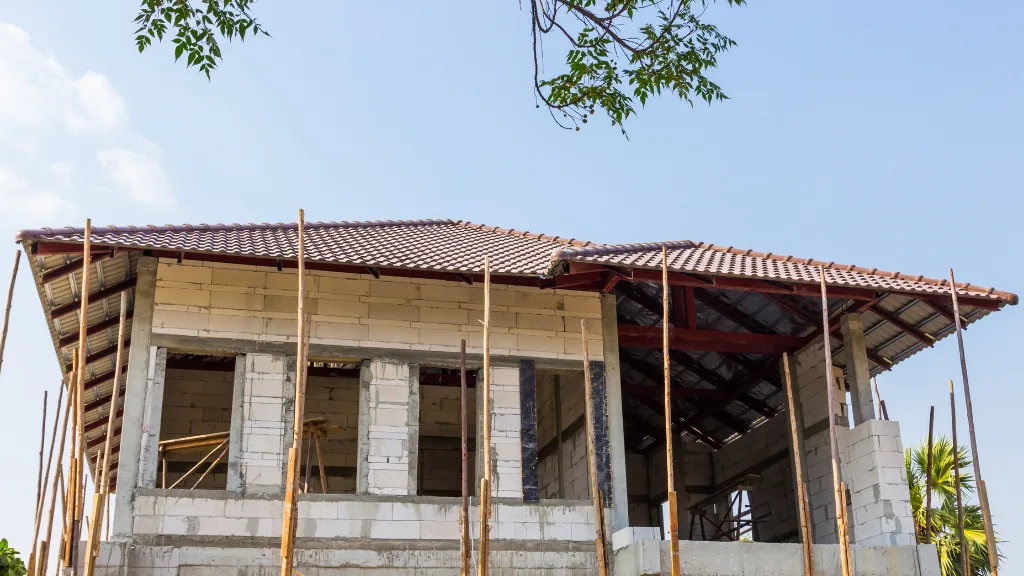
When it comes to roofing materials, solid concrete may not be the first material that comes to mind. However, this durable and long-lasting material is gaining popularity for its many benefits.
Solid concrete roofing can withstand extreme weather conditions, has a long lifespan, and requires minimal maintenance. In this article, we’ll explore the world of solid concrete roofing, including its pros and cons, cost, and installation process.
Whether you’re a homeowner looking to replace your old roof or a contractor searching for new roofing materials, this guide will give you all the information you need to know about solid concrete roofing.
So, let’s dive in and discover the benefits of this innovative roofing material.
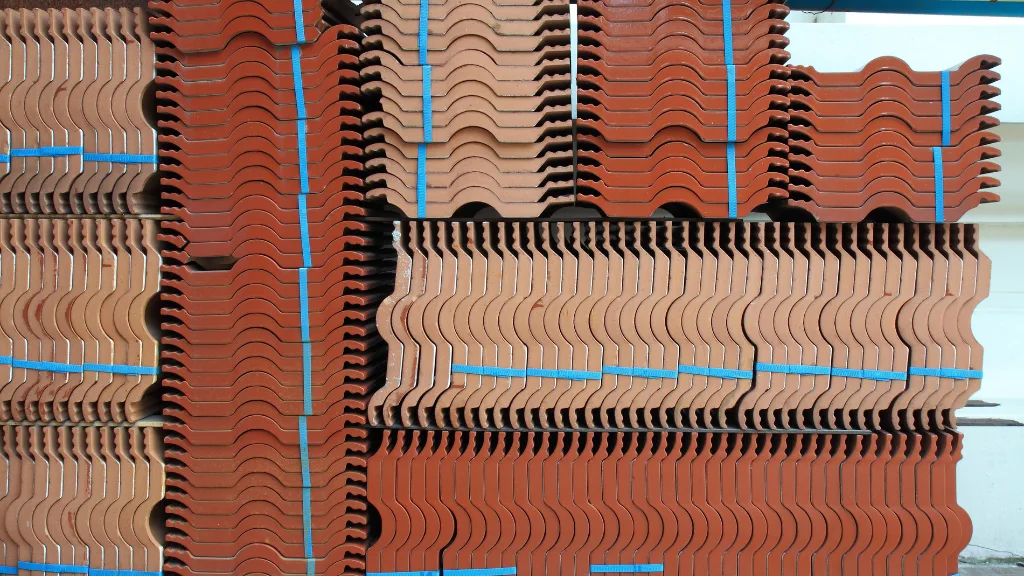
Types of Solid Concrete Roofing
Solid concrete roofing is a durable and long-lasting option for your home or building. There are two main types of solid concrete roofing systems: Concrete Roof Tiles and Solid Concrete Slab.
Concrete Roof Tiles
Concrete roof tiles are made by pouring concrete into a mold. They can be flat or curved, allowing them to mimic traditional roofing materials like slate and clay.
They are made from a combination of cement, water, sand, and other materials. The composition of the concrete varies based on the desired properties, such as strength, weight, and porosity.
Here are some advantages of using concrete roof tiles:
- Durable: Concrete roof tiles have a long lifespan, typically lasting 50 years or more with proper maintenance. They can withstand harsh weather conditions, including wind, rain, and hail.
- Fire-resistant: Concrete is a non-combustible material, making it resistant to fire damage.
- Energy-efficient: Concrete tiles can help insulate your home, reducing heat transfer and lowering your energy costs.
- Versatile design: With a wide range of colors, textures, and shapes available, concrete tiles can enhance the aesthetic appeal of your house or building.
However, there are a few drawbacks to consider:
- Weight: Concrete tiles are heavier than other roofing materials, such as wood or steel. This means that additional structural support may be needed.
- Expensive: While the tiles themselves may not be expensive, the installation process can be labor-intensive and costly.
Solid Concrete Slab
A solid concrete slab roof is a single, monolithic structure made by pouring concrete over a metal or wood framework.
This type of roof is commonly used on flat or low-slope roofs. It provides excellent strength and stability, as well as resistance to fire and water damage.
Advantages of solid concrete slab roofs:
- Durable: Like concrete tiles, a solid concrete slab roof has a long lifespan and can withstand harsh weather conditions.
- Low maintenance: With fewer seams and joints, a solid slab roof has a lower risk of leaks and requires minimal maintenance.
Disadvantages of solid concrete slab roofs:
- Weight: A solid concrete slab is heavy, which may require additional structural support.
- Cost: The cost to install a concrete slab roof can be higher compared to other roofing materials.
- Design limitations: Unlike concrete tiles, solid concrete slabs may offer fewer aesthetic design options.
When selecting a solid concrete roofing system, consider the weight, cost, and design limitations of each option. Consult with a roofing professional to determine which type of solid concrete roof is best suited for your needs.

Benefits of Solid Concrete Roofing
As a homeowner, you may be considering solid concrete roofing for your home due to its various advantages. Concrete roofs offer impressive durability, withstanding water damage far better than traditional asphalt shingles.
Moreover, the polymer-based concrete tiles can last for decades without requiring extensive maintenance.
Solid concrete roofing has the ability to support substantial weight, making it an excellent choice for extra floors, decks, or parking spaces. Additionally, you’ll find that concrete roofs help protect your home from temperature fluctuations, effectively insulating against heat and cold while also reducing energy costs.
Concrete tiles are available in various textures and finishes, allowing you to choose a suitable design that complements your home’s exterior.
Though they are heavier than some other roofing materials, the tiles offer an array of benefits that outweigh the added weight. For instance, concrete roof tiles can weigh between 800 pounds per 100 square feet (for 6″ x 6″ tiles) and 1,1200 pounds per 100 square feet (for 10″ x 10″ tiles).
When it comes to the underlying structure of a concrete roof, you’ll typically find a solid slab, several inches thick, capping the top of your house. This robust, immovable foundation enhances the overall stability and longevity of your roofing system.
In terms of cost, concrete roofs can be more expensive initially than traditional asphalt, clay, or slate options. However, the long-term benefits of low maintenance, durability, and energy efficiency often offset these upfront costs.
As a result, many homeowners find concrete roofs to be a worthwhile investment in the long run.
Adding to its environmental benefits, solid concrete roofing can be molded into unique shapes and designed to mimic other materials like clay, slate, or stone. This offers you the option to attain a classic or contemporary appearance without sacrificing the advantages of concrete itself.
So, if you’re considering a roofing upgrade or new installation, making the choice to go with solid concrete can provide numerous long-lasting benefits for your home, from durability and support to energy efficiency and versatile design options.
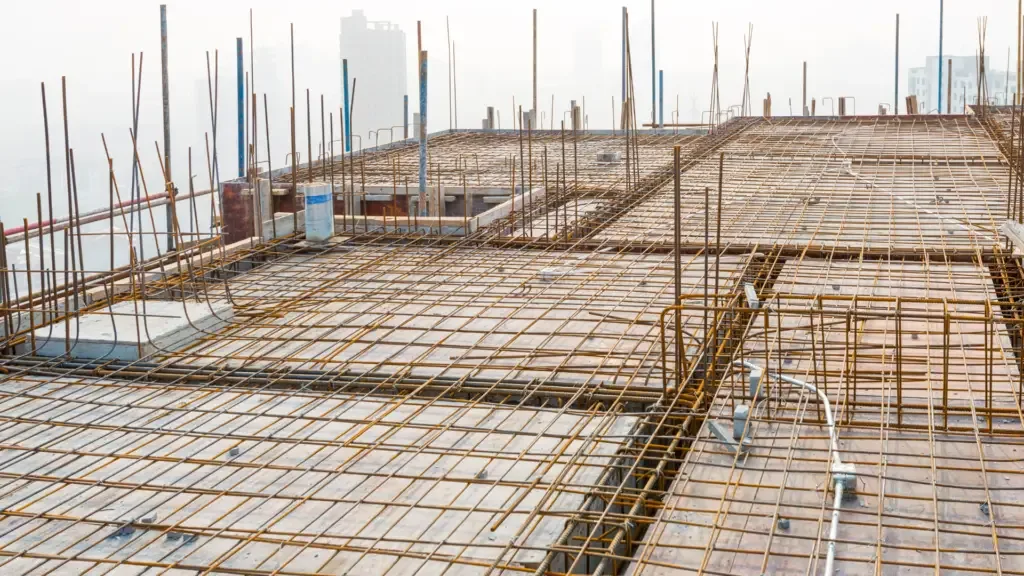
Composition and Construction
Concrete Mixture and Texturing
When it comes to solid concrete roofing, the concrete mixture plays a crucial role in ensuring its durability and longevity. Concrete roofing is composed of a blend of coarse aggregates, fine particles, cement, and water.
This mixture is combined to create a strong, stone-like material that is versatile and affordable. In comparison to other roofing options like asphalt shingles or metal roofing, concrete tiles are more resistant to high winds, termites, and rust.
After the concrete mixture is prepared, it’s essential to apply the proper texture to the concrete tiles. Texturing not only enhances the appearance of the roof, but it also improves the roof’s overall performance.
Various texturing techniques can be employed to emulate the appearance of traditional roofing materials, such as asphalt shingles or roofing tiles. This flexibility allows you to choose a style that complements the design of your house.
Roofing Support and Reinforcement
Solid concrete roofing requires a strong support system due to its heavy weight. The roof decking should have solid sheathing that provides a continuous surface at the plane of the roof.
This type of sheathing is necessary for composition roofing and built-up roofing which have no structural capacity themselves.
While constructing a solid concrete roof, incorporating additional reinforcement is essential to prevent potential damage caused by natural forces, such as high winds or seismic activity.
Reinforcing the concrete tiles with steel rebar can increase the tensile strength of the roof, thereby reducing the risk of cracks and structural failure.
Furthermore, proper installation of roof vents and other ancillary components by a skilled roofing contractor is crucial in maintaining the long-term performance and durability of your solid concrete roof.
These features ensure proper ventilation and prevent moisture build-up, which could lead to the weakening of the overall roof structure.
In conclusion, opting for a solid concrete roof involves careful attention to the concrete mixture, the texturing techniques employed, and adequate support and reinforcement to accommodate the weight of the materials.
By adhering to these guidelines, you can ensure the longevity and durability of your concrete roof, giving your home a robust and reliable shield against the elements.

Installation and Replacement
New Roof Installation
When installing a solid concrete roof, it’s important to ensure the structure can bear the weight of the roofing material. A reinforced roof deck with rebar and framing is necessary to support the heavyweight of a traditional solid concrete roof.
Prior to installation, treat the concrete roof or roof deck with densifying sealer to prevent moisture intrusion and protect the concrete from the inside out. Once the foundation is set, your contractor will install the concrete roofing tiles, which can be made to mimic the appearance of wood shake or slate roofing.
The tiles are fireproof, making them an excellent choice for areas prone to wildfires or where a high degree of fire resistance is desired.
Reroofing
If you’re considering reroofing your home with solid concrete, it’s essential to first assess your current roof’s structural integrity. Make sure your home is capable of supporting the extra weight of the concrete roof tiles.
If any adjustments are necessary, such as adding reinforced framing or rebar, it’s crucial to include these upgrades in your overall budget. The skilled contractor you’ve chosen will remove your existing roofing material, inspect and repair any damage, and ensure the deck is ready for the new concrete roof tiles.
Upgrades
When upgrading to a concrete roof from a traditional roof, consider the many benefits it can bring, such as longevity, durability, and resistance to extreme weather conditions, like hurricanes. There are, however, a few additional aspects to keep in mind during the process:
- Underlayment: Ensure a high-quality underlay is utilized to serve as a moisture barrier and protection from cracks, which can occur over time.
- Tile selection: Choose from various concrete roof tile styles, sizes, and colors, enhanced with oxide pigments that maintain color integrity and durability.
- Ventilation: Proper ventilation in your roof system is essential for temperature control and regulating moisture levels, so consult your contractor about effective solutions.
In summary, when installing, reroofing, or upgrading to a solid concrete roof, take care to consider the structural requirements, use a high-quality underlayment, and make style and ventilation choices that suit your unique needs.
With careful planning and execution, a concrete roof can provide a durable and appealing solution for your home.
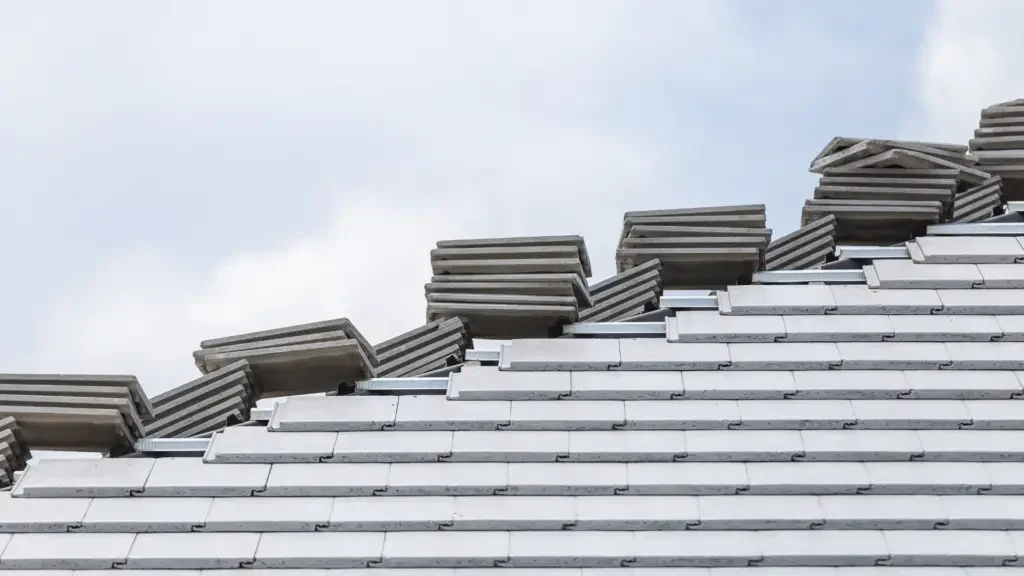
Maintenance and Repair
Preventive Measures
To ensure the longevity and appearance of your solid concrete roof, it’s important to take preventive measures. Some key steps you can take include:
- Gutters and debris: Keep your gutters clean and free of debris. This helps prevent water intrusion and damage to the underlying plywood or support structure.
- Algae and molds: Regularly inspect your roof for signs of algae or mold growth. Apply an algae-resistant treatment if necessary, and trim back any overhanging branches to allow sunlight to reach the roof and inhibit growth.
- Pressure washing: It may be tempting to pressure wash your concrete roof to remove dirt and stains, but be cautious. High pressure can damage the tiles, remove protective coatings, and cause water intrusion. If you must pressure wash, use a gentle setting and ensure the tiles are completely dry before re-applying any treatments.
Repair Techniques
Should any issues arise with your concrete roof, there are several repair techniques to consider:
- Fasteners: Over time, fasteners can become loose or corroded. Regularly inspect and replace any damaged fasteners to maintain the integrity of your roof.
- Tile replacement: If a tile is cracked or damaged, it’s important to replace it promptly to avoid water intrusion and damage. Carefully remove the damaged tile, clean the area, and replace it with a new tile. Then, secure the new tile with appropriate fasteners.
- Patching: Small cracks or chips in tiles can often be repaired using a patching compound or cement specifically designed for concrete roof tiles. Apply the compound to the damaged area, smooth it out, and allow it to dry before applying any treatments or coatings.
Remember, the best approach to maintaining your concrete roof is prevention. By regularly inspecting your roof and addressing any potential issues before they escalate, you’ll be able to protect your investment, maintain the appearance of your home, and experience the many benefits a solid concrete roof can offer.

Comparisons with Other Roofing Materials
In this section, you will learn about how solid concrete roofing compares to other popular roofing materials such as metal roofing, asphalt shingles, and clay and slate tiles.
Metal Roofing
When compared to metal roofing, solid concrete roofs can offer better insulation and durability, but they come with a higher initial cost. Metal roofing materials, such as steel and aluminum, typically range from $100 to $300 per square.
In contrast, concrete tiles can range from $150 to $250 per square for standard weight and $350 to $500 for lightweight versions. While metal panels might be a more affordable option initially, they could require more maintenance and may not be as energy efficient as concrete roofs.
Asphalt Shingles
Asphalt shingles are a common choice for roofing due to their low cost and ease of installation. However, when compared to solid slab concrete roofing, they may not provide the same level of durability and insulation.
Furthermore, if you live in an area prone to earthquakes, a solid concrete roof could be a safer choice, as it is more resistant to seismic movement. You should also consider your local building codes, as some areas might require specific materials or designs for roofs, especially in earthquake-prone regions.
Clay and Slate Tiles
Concrete roofing can mimic the appearance of clay and slate tiles, making it a versatile option for those seeking a traditional aesthetic. Clay tile roofs generally cost between $200 and $600 per square, while slate can range from $300 to $600 per square for authentic slates and $200 to $300 for synthetic ones.
In terms of engineering, both clay and slate tiles require sloping roofs and proper structural support due to their weight.
In conclusion, when deciding on a roofing material, you should consider factors such as your budget, local building codes, durability, and resistance to natural disasters.
Solid concrete roofing provides a strong and energy-efficient option that can mimic the appearance of other roofing materials, making it a suitable choice for a variety of situations.
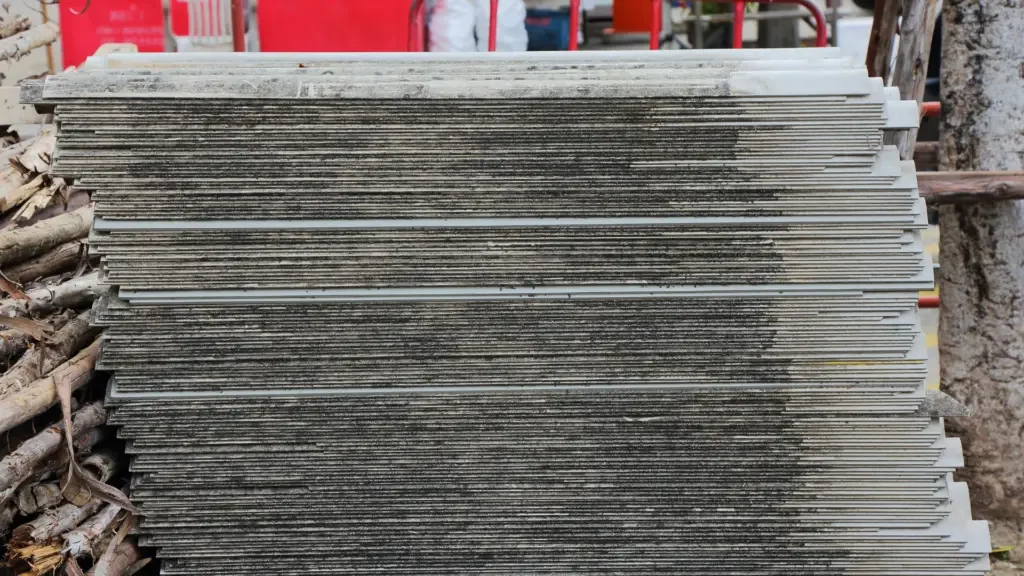
Considerations for Homeowners
Location and Climate Factors
When considering solid concrete roofing for your home, it’s important to take into account your location and climate. Factors such as extreme weather conditions, susceptibility to natural disasters, and local building codes play a significant role in determining the suitability of this roofing option.
- Slate tiles, clay tiles, and architectural shingles are alternative materials that may offer better performance in specific climates or locations. For example, slate and clay tiles are more suitable for areas with heavy rainfall and high humidity, while architectural shingles are a popular choice in colder climates with heavy snowfall.
- Category 5 hurricanes can cause extreme wind damage, and a solid concrete roof reinforced with steel rebar can provide the necessary protection against these severe weather events.
- Always consult with local roofing contractors to ensure your choice of roofing material complies with local building codes and is well-suited for your region’s climate.
Budget and Warranty
Solid concrete roofing, while durable and low-maintenance, may not be the most budget-friendly choice compared to alternatives such as asphalt shingles or metal roofs. However, they can offer some long-term cost savings due to their resilience and low-maintenance requirements.
Consider the following aspects related to budget and warranty when making your decision:
- Initial cost: A solid concrete roof consists of a slab of concrete reinforced with steel rebar and covered with a roof membrane, which can make it a more expensive option compared to other materials. However, this investment may be worth it if you live in an area where strong winds or harsh weather conditions are common.
- Maintenance cost: Most homeowners spend less than $100 or up to $1,000 per year to maintain their concrete roof. Since it’s a low-maintenance surface, you could save on maintenance expenses over time.
- Roof warranty: Manufacturers typically offer a 30-year lifespan guarantee for concrete roof tiles. Be sure to discuss the warranty coverage with your roofing contractor, as it can provide assurance and protection for your investment.
By carefully considering the factors mentioned above, you can make an informed decision about whether a solid concrete roof is an appropriate choice for your home.
Remember to consult with local roofing contractors and adhere to local building codes to ensure your roofing project is completed safely and efficiently.

